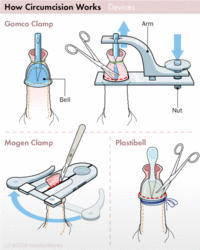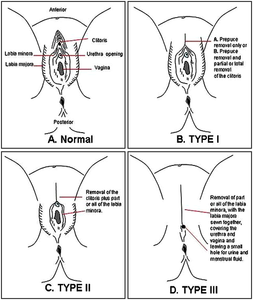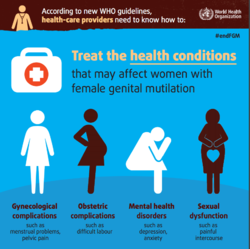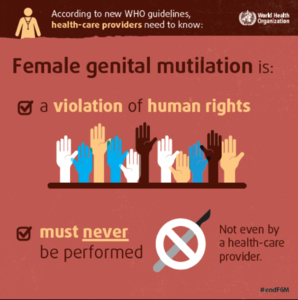Routine Infant Circumcision
The Medicalization of Circumcision
Medicalization is a concept originally thought of by Michael Foucault and it explains the increasing prevalence of medical practices within society. [1] In other words, Medicalization helps explain how culture and society greatly influences medical practices throughout the world. Being a social construction, Medicalization varies throughout different countries and communities and therefore, depending on the society you are in, some common practices may be perceived differently than others. That being said, Routine Infant Circumcision is a common procedure within the contemporary world.
Male Circumcision
The most common form of circumcision in the contemporary world involves the removal of the foreskin on the male genitalia. This occurs usually at the newborn stage of an individuals life, but the procedure can be done later in the individual's life, but the surgical process will be far more difficult.
Circumcision is often done as a religious practice, but it has become common that newborns be circumcised for family preference or tradition, aesthetic purposes, personal hygiene, and to prevent future potential health risks such as sexually transmitted diseases. [2] Male Circumcision is also done in some situations in which there is a medical requirement for the procedure to be done, most commonly, when the foreskin is too tight to be pulled over the glans.
The historical practice of Circumcision stretches earlier before even biblical times, with many speculating its origins were from Eastern Africa. Theories believed that circumcision, or genital mutilation in general was a common practice in order to 'purify' an individuals sexuality and sexual desires, as removing body parts in which pleasure is often achieved ultimately 'purifies' the individual from such desires. [3]
Procedure

Male Circumcision occurs through a surgical operation most commonly performed early in the newborn phase of an individuals life. There are three common procedures in which the circumcision is performed in which all involve an instrument to be placed over the head of the penis, and the foreskin pulled over top of the instrument. The three common practices of circumcision include: The Gomco Clamp, The Mogen Clamp, and the Plastibell Clamps may be used to minimize the blood flow towards the tip of the penis, and once the foreskin is over the instruments, the foreskin is then surgically removed with a scalpel.[4]
The procedure rarely takes longer than 10 minutes, as it is quite a simple surgery to perform. The surgery is performed within the first 3 days of the newborn's birth, but it is a Jewish Tradition and Celebration for a newborn male to be circumcised on the 8th day post birth. Recovery rarely takes longer than 2 weeks, as most recoveries are completed in under a week and a half.
Effects
Circumcision often has no detrimental effects in the long run, but the most common effect of being circumcised is ultimately losing some sexual satisfaction. It is common for individuals who are circumcised to lose sensation in the glans of their Penis as it is constantly exposed, and uncovered throughout life. Men report on having decreased sexual pleasure and decreased orgasm intensity as a result of being circumcised. Men also reported that more stimulation was required to achieve an orgasm with a circumcised penis.[5]
Benefits
Aside from personal preference and religious rituals, people chose to be circumcised for future health benefits throughout the lifetime. These health benefits include a decreased risk of Urinary Tract Infections, prevention of penile cancer, easier hygiene as it is much easier to clean the penis without having foreskin, but most importantly, the main benefit of having a circumcised penis is to prevent future potential Sexually Transmitted diseases and infections.[6] In a recent study Liu et al. it was discovered that having a circumcised penis greatly reduces the amount of microbiomes of the penis. This means in simpler terms that, when having a circumcised penis, researches discovered that there was dramatically less bacteria living on the penis. That being said, random control tests were performed, and as a result, it showed that circumcision reduced the risk of an HIV infection by 50-60%.[7]
Female Circumcision
Female Circumcision, more commonly known as Female Genital Mutilation is less common than male circumcision, but much more serious and controversial. Female circumcision is a ritualistic practice most commonly found in Africa, Asia, and other Middle Eastern Countries. It involves the alteration of appearance of a women's genital region, and has many different forms. Female Circumcision can vary between the cutting of a women's clitoral hood, the complete removal of the clitoris, cutting of the inner or outer labia, and other various procedures that ultimately remove portions of a women's vagina. The World Health Organization estimates that more than 200 million girls and women within African, Asian, and Middle Eastern Countries have had some alteration done to their genitals. Like male circumcision, female circumcision occurs usually within early infancy, but it is also not rare for procedures to be done throughout childhood and adolescence.[8]
Methods
There are various types of female circumcision, all of which involve the removal of a portion of a women's genital. (The following Information is retrieved from the World Health Organization website.)[9]

Type I
Type I female circumcision involves the partial or complete removal of the clitoris. This is commonly called a clitoridectomy. Type I female circumcision may also include the complete removal of the clitoral prepuce, more commonly known as the clitoral hood.
Type II
Type II female circumcision involves the partial or complete removal of both the labia minora as well as the clitoris. This type of female circumcision is commonly referred to as excision as it may or may not always involve an excision of the labia majora.
Type III
Type III female circumcision is known to be the most serious and painful form of circumcision. This procedure involves making the vaginal opening smaller and narrower by creating a covering which will partially block and obstruct the opening. This procedure is commonly called infibulation. The covering created to block the vaginal opening is created by cutting the labia majora, or labia minora, and is altered or stitched close to create a cover. There is a small opening left to allow for the flow of urine and menstrual blood.
Type IV
Type IV female circumcision refers to all other alterations of a female's genitalia for non medical purposes. This includes piercings, scrapings, incisions, etc.
Effects
Female circumcision is a procedure which is proven to have no health benefits at all. That being said, there are many issues associated with female circumcision, some of which occur right after the procedure, and others occurring later on throughout the women's life.

Long Term
There are serious long term effects as a result of female circumcision. Most commonly, individuals may have decreased sexual pleasure and desire due to the removal of the clitoris and in some cases pain during intercourse. Others may have personal psychological issues regarding self esteem and self confidence throughout their lives. Other long term effects of female circumcision may include scaring, and increased risk during childbirth. A medical procedure called deinfibulation is required for individuals who have been type III circumcised. This procedure requires the reopening of the vagina for sexual intercourse, and child birth.[10]
Short Term
Short term effects of Female circumcision commonly include excessive bleeding, pain, discomfort, and in some serious cases, immediate infections. Because female circumcision is common in developing countries, and not done by professional health care providers, it is possible for the individual to develop infections through the contamination of unsterile equipment tools, and lack of hygienic facilities.
Circumcision Throughout Cultures
As stated earlier, circumcision is a commonly performed as a sacred ritual throughout different cultures in the world. The history of circumcision goes as far back as to biblical times, and is most commonly found within the Jewish cultures around the world. In the Jewish faith, circumcision is performed on the 8th day post birth, or during the teenage years of the males life. This tradition originated in the biblical book of Genesis where God and Abraham made a covenant in which Abraham was to be circumcised and his children to be circumcised as well on the eighth day of birth.
Circumcision is also a sacred ritual for Muslim cultures. Though, circumcision is not stated directly in the Koran, circumcision is considered to be cleansing of the individual to be as similar to Prophet Mohammad as possible as well as a symbolic representation of entering manhood. Contradictory to Judaism, circumcision in the Islamic culture occurs not at childbirth, but between the ages 2-14.[11]
Female Circumcision is a common procedure in Africa, the Middle East, and in Asia. Though it is not a religious tradition within these cultures, female circumcision is a tradition that continues because of social pressures within these communities. The practice is prevalent because of the pressures to conform to the social norms within these societies, and the fear of being rejected within them if the procedure is not done. For type 3 female circumcisions, this procedure is often done throughout cultures to ensure premarital virginity, and because of the procedures, it makes women have less sexual desires throughout her life.[12]
Ethics

One of the main ethical concerns revolving around circumcision throughout society is that the circumcision procedure provides unnecessary and uncontrollable amount of pain to a newborn child. Because the procedure is normally done without any form of anesthesia, the infant is without a doubt experiencing a large amount of pain, which classifies circumcision as an unethical medial procedure.[13]
Female Circumcision draws most of societies attention regarding ethical concerns. Because female circumcision has no medical and health benefits, female circumcision solely causes harm to the individuals. Similar to male circumcision, female circumcision causes a lot of harm to the individual, and infections are not uncommon post procedure. Female genital mutilation is considered to be a violation of basic human rights. This is because the procedure is irreversable, and causes unnecessary harm to women, often leading to issues and problems in the future. The procedure is also done during the childhood stages of the females life, where the girl herself is unable to make her own decision, and is ultimately forced into the situation.[14] There are also ethical concerns regarding the parental pressure parents have on their daughters regarding the procedures. That being said, even when the procedure is done when the women is in her adolecence, she still does not have full consent over the procedure, as there will always be the parental and family pressure on the individual herself.[15]
Sources
- ↑ "medicalization." A Dictionary of Sociology. . Encyclopedia.com. 7 Aug. 2017 <http://www.encyclopedia.com>.
- ↑ Mayo Clinic Staff. "Circumcision (male)." Mayo Clinic. Mayo Foundation for Medical Education and Research, 20 Feb. 2015. Web. 07 Aug. 2017.
- ↑ Circumcision Information and Research Pages. "History of Circumcision. N.p., 28 Aug. 2011. Web. 07 Aug. 2017. <http://www.cirp.org/library/history/>.
- ↑ "Surgeries and Procedures: Circumcision." KidsHealth. Ed. Larissa Hirsch. The Nemours Foundation, June 2016. Web. 07 Aug. 2017. <http://kidshealth.org/en/parents/procedure-circumcision.html#>.
- ↑ Bronselaer, G. et al., "Male Circumcision Decreases Penile Sensitivity as Measured in a Large Cohort," BJU International 111 (2013): 820-827. http://www.ncbi.nlm.nih.gov/pubmed/23374102?dopt=Abstract
- ↑ Mayo Clinic Staff. "Circumcision (male) Why it's done." Mayo Clinic. Mayo Foundation for Medical Education and Research, 20 Feb. 2015. Web. 09 Aug. 2017. <http://www.mayoclinic.org/tests-procedures/circumcision/basics/why-its-done/prc-20013585>.
- ↑ Liu CM, Hungate BA, Tobian AAR, Serwadda D, Ravel J, Lester R, Kigozi G, Aziz M, Galiwango RM, Nalugoda F, Contente-Cuomo TL, Wawer MJ, Keim P, Gray RH, Price LB. 2013. Male circumcision significantly reduces prevalence and load of genital anaerobic bacteria. mBio 4(2):e00076-13. doi:10.1128/mBio.00076-13.
- ↑ Female Genital Mutilation/Cutting: A Global Concern. UNICEF, New York, 2016.
- ↑ Female Genital Mutilation/Cutting: A Global Concern UNICEF, New York, 2016.
- ↑ "What is FGM." End FGM. N.p., n.d. Web. 09 Aug. 2017. <http://www.endfgm.eu/female-genital-mutilation/what-is-fgm/>.
- ↑ Circumcision Practices Around the World. (n.d.). Retrieved August 11, 2017, from http://www.circumcisioninformation.com/circ_world.html
- ↑ Female genital mutilation. (n.d.). Retrieved August 12, 2017, from http://www.who.int/mediacentre/factsheets/fs241/en/
- ↑ Circumcision, Ethics, and Medicine. (n.d.). Retrieved August 12, 2017, from http://www.circumcision.org/ethics.htm
- ↑ Ethics - Female circumcision. (2014). Retrieved August 12, 2017, from http://www.bbc.co.uk/ethics/femalecircumcision/femalecirc_1.shtml
- ↑ Cook, R. J. (April 2008). African Journal of Reproductive Health. Ethical concerns in female genital cutting, 12(1). Retrieved from http://www.bioline.org.br/pdf?rh08001